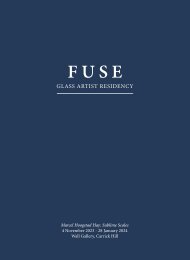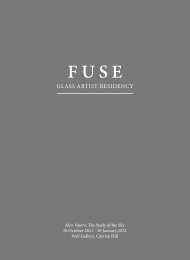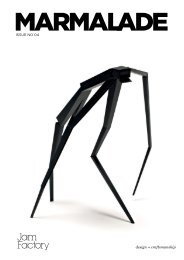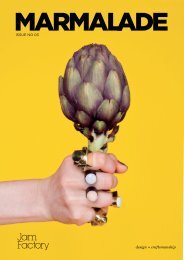Marmalade Issue 5, 2017
Create successful ePaper yourself
Turn your PDF publications into a flip-book with our unique Google optimized e-Paper software.
‘The job you didn’t know<br />
you always wanted’: the<br />
2016 Australian tapestry<br />
workshop trainee program<br />
Words by Emeritus Professor Kay Lawrence<br />
Kay is the Head of the South Australian School of Art,<br />
University of South Australia.<br />
The 1970s in Australia was a buoyant decade for the visual<br />
arts, craft and design. South Australia and Victoria (at the<br />
time led by visionary premiers Don Dunstan and Rupert<br />
Hamer respectively) saw cultural development, especially the<br />
creation of craft and design based organisations, as bringing<br />
a distinctive character to each state as well as offering<br />
training and employment in the arts. They saw their role<br />
as being key to the development of an economically viable<br />
cultural sector. In South Australia this vision was realised with<br />
the establishment of the South Australian Craft Authority<br />
(later JamFactory) in 1973. The organisation was set up to<br />
provide professional training for crafts people, establish sales<br />
outlets for high-quality craft and design, and to promote<br />
the development of design-led mass-production in South<br />
Australia. Aware that Australian artists were increasingly<br />
commissioning European workshops to translate their<br />
paintings into woven tapestry, the Victorian government<br />
grasped the opportunity to create an Australian-based<br />
workshop to interpret the work of Australian artists into<br />
tapestry for public commission. To this end, in 1976 they<br />
established the Victorian Tapestry Workshop now the<br />
Australian Tapestry Workshop (ATW).<br />
The ancient practice of tapestry weaving was little known<br />
in Australia in the 1970s, although post-war migration in the<br />
1950s and 1960s had attracted a number of skilled weavers<br />
from Europe to set up professional practice in New South<br />
Wales. But the impetus for the blossoming of woven tapestry<br />
in Australia came from Archie Brennan, Director of the<br />
Edinburgh Tapestry Company (also known as the Dovecot),<br />
and Belinda Ramson who worked with Brennan at the<br />
Dovecot in the late 1960s. Brennan and Ramson conducted<br />
a series of tapestry workshops in Victoria, New South Wales<br />
and South Australia in the mid-1970s and in 1974 Brennan was<br />
appointed as advisor to the committee convened to establish<br />
the ATW. He suggested that an evolutionary philosophy<br />
be taken to the development of the workshop in order to<br />
develop a distinctly Australian outlook to the translation of<br />
artworks into tapestry. He recommended working with the<br />
most interesting and challenging contemporary artists and<br />
taking a collaborative approach to both interpretation and<br />
weaving. By recruiting a small group of trainees with art<br />
school qualifications, and offering them training in tapestry<br />
technique and time to develop their own tapestry language<br />
before undertaking commissions, the workshop would be<br />
able to develop its own ethos and ways of working. Belinda<br />
Ramson was employed for four intensive weekend workshops<br />
to pass on her own meticulous skills to a group of 13 art<br />
school graduates selected from 150 applicants from across<br />
Australia. Five of these participants became the foundation<br />
weavers of the ATW: Cresside Collette, Marie Cook, Merrill<br />
Dumbrell, Sara Lindsay and Liz Nettleton, joined six months<br />
later by Cheryl Thornton and apprentice Sue Batten (nee<br />
Hick) recruited straight from school.<br />
Forty years later 76 weavers have been trained and have<br />
worked at the ATW, many staying for 20 years or more while<br />
others developed their own professional practices in the<br />
medium. Their accumulated expertise can be recognised in<br />
the distinctive approach to tapestry weaving developed at<br />
the workshop. ATW tapestries are noted for their superlative<br />
technique, mastery of colour and tone, and an approach<br />
to interpretation that employs the particular characteristics<br />
of weaving to bring out the unique qualities of the<br />
original artwork.<br />
ISSUE 05 / 45











